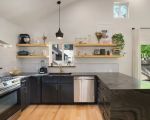Transform Your Home: Easy Steps to Achieve a Modern Look
When I decided to renovate my home to give it a more modern look, I knew it wouldn’t be an easy task. The house had great bones but needed a lot of updates to bring it into the current decade. I wanted a home that felt contemporary, functional, and stylish, but I also didn’t want to spend a fortune. Over time, I discovered some simple yet impactful strategies that could transform the look and feel of any space. Let me share my journey of home renovation and give you some tips and tricks to renovate your home for a modern look.
1. Start with a Clean Slate: Declutter and Simplify
Before diving into renovations, I realized the importance of starting with a clean slate. My first step was to declutter each room, making sure I had a fresh space to work with. I began by removing excess furniture, outdated décor, and items that no longer served a purpose. This step was surprisingly therapeutic and allowed me to visualize the modern design I wanted to achieve. Once the clutter was gone, the rooms felt bigger and more open, which is key to modernizing your home.
Modern design is often centered around simplicity. As I removed unnecessary items, I began to appreciate how much more space I had to work with. For anyone looking to renovate their home, I’d recommend taking a hard look at what you truly need and love, and removing anything that detracts from a clean, organized space. This creates the perfect backdrop for a modern update.
2. Embrace Neutral Colors for a Sleek Look
Once I cleared out the space, the next step was choosing a color palette. I knew that modern design often favors neutral tones—whites, grays, blacks, and even soft beige. For my walls, I opted for a light, warm gray. It gave the space an airy feel and acted as a perfect neutral base for the rest of the renovation. I also decided to go with crisp white trim to keep the look fresh and clean.
Incorporating pops of color can be done through furniture, artwork, and accessories. In my case, I added a few bold, geometric accent pieces in the living room, such as a statement rug and some colorful pillows. These small touches helped break up the neutral tones while maintaining a modern aesthetic. Choosing a neutral base for the walls and larger furniture pieces allows you to add personality to the space with accessories, and it also keeps the overall design versatile and timeless.
3. Upgrade to Modern Fixtures and Lighting
One of the most noticeable changes I made during my renovation was upgrading the lighting fixtures. The old ceiling fans and dated chandeliers were replaced with sleek, modern pendant lights and recessed lighting. I knew that lighting could make or break the modern aesthetic I was going for, so I carefully chose fixtures that were minimalistic yet elegant.
One of my favorite upgrades was installing dimmable recessed lighting in the kitchen and living areas. It provided flexibility in adjusting the light levels based on the time of day and mood. Modern lighting fixtures like track lights, floor lamps, and simple overhead lights can add sophistication to any room. Additionally, I chose energy-efficient LED lights, which not only contributed to a modern look but also helped reduce electricity bills in the long run.
4. Invest in High-Quality, Modern Furniture
Furniture played a significant role in my home’s transformation. I wanted pieces that reflected modern design principles: clean lines, neutral colors, and functional beauty. I swapped out bulky, traditional furniture for sleek, low-profile sofas, minimalistic coffee tables, and streamlined storage units. This furniture change instantly updated the space and gave the home a fresh, contemporary feel.
When choosing modern furniture, consider materials like glass, metal, and wood. I opted for a mix of these to keep things balanced and interesting. My living room now features a glass coffee table, a velvet sofa in a deep blue shade, and a few metallic accents. The key to modern furniture is functionality combined with simple, elegant design. Be sure to choose pieces that complement your color palette and make your space feel open and organized.
5. Focus on Open Spaces and Smart Layouts
Modern homes often feature open floor plans with a sense of fluidity between spaces. As part of my renovation, I focused on enhancing the flow between rooms. I knocked down a few non-structural walls to create an open-concept kitchen and living room. This change not only made the home feel larger but also allowed for better natural light to flow throughout the space.
When planning a renovation, think about how the space can be used most efficiently. I created multi-functional spaces by choosing modular furniture that could easily be rearranged. Modern homes often emphasize the importance of smart layouts—where the space feels connected, yet distinct areas for different activities are easily defined. I also made sure to incorporate plenty of storage, as modern design values both aesthetics and practicality.
6. Add Minimalist Art and Décor
Once the structure of the house was modernized, I moved on to adding artwork and décor. I realized that minimalist art is a great way to add personality without overwhelming the space. I hung a few abstract paintings and framed black-and-white photography in the living room, which complemented the neutral color scheme and added visual interest without clashing with the modern vibe.
When choosing décor, keep it simple and purposeful. I avoided cluttering the space with too many accessories. Instead, I selected a few high-quality, meaningful pieces, such as a geometric vase and a sleek bookshelf. Modern design is all about creating a balanced, serene environment, so each item should serve a purpose or add to the overall atmosphere of the room.
7. Use Natural Materials for a Warm, Modern Touch
While modern design is often associated with sleek, clean lines, it’s important to bring warmth into the space as well. For this reason, I decided to incorporate natural materials like wood and stone. I installed hardwood floors in the main living areas, which added texture and warmth, and I used stone tiles in the kitchen and bathrooms for a sophisticated yet organic touch.
Natural materials are perfect for modern spaces because they add depth and create a harmonious contrast with more industrial elements like metal and glass. I also used wooden shelving and accents throughout the home, which provided a natural element that softened the modern aesthetic while keeping things grounded.
Renovating your home to achieve a modern look doesn’t have to be overwhelming or expensive. By focusing on clean lines, functional furniture, high-quality finishes, and smart layouts, you can transform your living space into a stylish, contemporary haven. Whether you’re starting small with a few updates or doing a complete renovation, these tips can help you create the modern home of your dreams.
If you're ready to begin your home renovation journey, check out Improvement for expert tips, contractor recommendations, and the best services to make your modern home makeover a reality!








